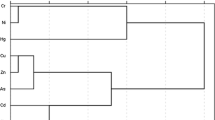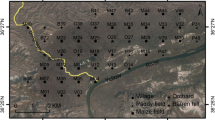Abstract
Purpose
The effect of soil heavy metals on crops and human health is an important research topic in some fields (Agriculture, Ecology et al.). In this paper, the objective is to understand the pollution status and spatial variability of soil heavy metals in this study area. These results can help decision-makers apportion possible soil heavy metal sources and formulate pollution control policies, effective soil remediation, and management strategies.
Materials and methods
A total of 212 topsoil samples (0–20 cm) were collected and analyzed for eight heavy metals (Cd, Hg, As, Cu, Pb, Cr, Zn, and Ni) from agricultural areas of Yingbao County in Lixia River Region of Eastern China, by using four indices (pollution index (PI), Nemerow pollution index (PIN), index of geo-accumulation (I geo), E i /risk index (RI)) and cluster analysis to assess pollution level and ecological risk level of soil heavy metals and combining with geostatistics to analyze the concentration change of heavy metals in soils. GS+ software was used to analyze the spatial variation of soil heavy metals, and the semi-variogram model is the main tool to calculate the spatial variability and provide the input parameters for the spatial interpolation of kriging. Arcgis software was used to draw the spatial distribution of soil heavy metals.
Results and discussion
The result indicated that the eight heavy metals in soils of this area had moderate variations, with CVs ranging from 23.51 to 64.37 %. Single pollution index and Nemerow pollution index showed that about 2.7 and 1.36 % of soil sampling sites were moderately polluted by Cd and Zn, respectively. The pollution level of soil heavy metals decreased in the order of Cd > Zn > Pb > As > Cu > Cr > Ni > Hg. The I geo values of heavy metals in this area decreased in the order of Zn > Cd > As > Pb > Cu > Cr > Hg > Ni. According to the E i index, except Cd that was in the moderate ecological risk status, other heavy metals in soils were in the light ecological risk status, and the level of potential ecological risk (RI) of soil sampling sites of the whole area was light.
Conclusions
The results of four indices and the analysis of spatial variation indicated that the contents of Cd and Zn were contributed mainly by anthropogenic activities and located in the south-east of this study area. However, the contents of Hg, As, Cu, Pb, Cr, and Ni in soils were primarily influenced by soil parent materials.





Similar content being viewed by others
References
Chang CY, Yu HY, Chen JJ, Li FB, Zhang HH, Liu CP (2014) Accumulation of heavy metals in leaf vegetables from agricultural soils and associated potential health risks in the Pearl River Delta. South China. Environ Monit Assess 186:1547–1560
Chen HY, Teng YG, Lu SJ, Wang YY, Wang JS (2015) Contamination features and health risk of soil heavy metals in China. Sci Total Environ 512–513:143–153
China Green Food Development Center (1994) Environmental Quality Assessment for Green Food Production Program. Science Press, Beijing, China, in Chinese
China Ministry of Environmental Protection (1995) Environmental Quality Standard for Soils(GB 15618–1995, Putting Into Effect As of Mar.1, 1996) (in Chinese)
China Ministry of Environmental Protection (2004) The Technical Specification for Soil Environmental Monitoring(HJ/T 166–2004, Putting Into Effect As of Dec.9, 2004) (in Chinese)
Facchinelli A, Sacchi E, Mallen L (2001) Multivariate statistical and GIS-based approach to identify heavy metal sources in soils. Environ Pollut 114:313–324
Goovaerts P (1997) Geostatistics for Natural Resources Evaluation. Oxford University Press, NewYork
Hakanson L (1980) An ecological risk index for aquatic pollution control.A sedimentological approach. Water Res 14(8):975–1001
Huang PM, Gobran GR (2005) Biogeochemistry of Trace Elements in the Rhizosphere. Elsevier, Amsterdam
Huang SS, Liao QL, Hua M, Wu XM, Bi KS, Yan CY, Chen B, Zhang XY (2007) Survey of heavy metal pollution and assessment of agricultural soil in Yangzhong district, Jiang Su Province, China. Chemosphere 67:2148–2155
Liu XM, Song QJ, Tang Y, Li WL, Xu JM, Wu JJ, Wang F, Brookes PC (2013) Human health risk assessment of heavy metals in soil–vegetable system: a multi-medium analysis. Sci Total Environ 463–464:530–540
Lu AX, Wang JH, Qin XY, Wang KY, Han P, Zhang SZ (2012) Multivariate and geostatistical analyses of the spatial distribution and origin of heavy metals in the agricultural soils in Shunyi, Beijing, China. Sci Total Environ 425:66–74
Lu WD (2010) SPSS statistical analysis, 4th edn. Publishing House of Electronics Industry, Beijing
Mireles F, Davila JI, Pinedo JL, Reyes E, Speakman RJ, Glascock MD (2012) Assessing urban soil pollution in the cities of Zacatecas and Guadalupe, Mexico by instrumental neutron activation analysis. Microchem 103:158–164
Mohamed I, Ahamadou B, Li M, Gong CX, Cai P, Liang W, Huang QY (2010) Fractionation of copper and cadmium and their binding with soil or ganic matter in a contaminated soil amended with organic materials. J Soils Sediments 10:973–982
Nagajyoti PC, Lee KD, Sreekanth TVM (2010) Heavy metals, occurrence and toxicity for plants: a review. Environ Chem Lett 8(3):199–216
Rodríguez Martín JA, Ramos-Miras JJ, Boluda R, Gil C (2013) Spatial relations of heavy metals in arable and greenhouse soils of a Mediterranean environment region (Spain). Geoderma 200–201:180–188
Romic M, Romic D (2003) Heavy metals distribution in agricultural topsoils in urban area. Environ Geol 43:795–805
Taylor SR, McLennan SM (1995) The geochemical evolution of the continental crust. Rev Geophys 33:241–265
Webster R, Oliver MA (2001) Geostatistics for Environmental Scientists. Wiley, Chichester
Wei B, Yang L (2010) A review of heavy metal contaminations in urban soils, urban road dusts and agricultural soils from China. Microchem 94:99–107
Wong SC, Li XD, Zhang GQ, Min YS (2002) Heavy metals in agricultural soils of the Pearl River Delta, South China. Environ Pollut 119:33–44
Xu Z, Ni S, Tuo X, Zhang C (2008) Calculation of heavy metals’ toxicity coefficient in the evaluation of potential ecological risk index. Environ Sci Technol 31(2):112–115
Yaylalı-Abanuz G (2011) Heavy metal contamination of surface soil around Gebze industrial area, Turkey. Microchem 99(1):82–92
Yin S, Lv HJ, Guo YX, Huang WH, Gang L (2013) An analysis of surface soil of city on levels of pollution based on nemerow index and geoaccumulation index. China Academic Journal Electronic Publishing House, CNKI, pp 698–701
You DM (2014) Monitoring and spatial estimation of contents of soil heavy metals (Doctor degree paper). China Agricultural University, Beijing, China
Zhao KL, Liu XM, Zhang WW, Xu JM, Wang F (2011) Spatial dependence and bioavailability of metal fractions in paddy fields on metal concentrations in rice grain at a regional scale. J Soils Sediments 11:1165–1177
Zhao Y, Xu X, Sun W, Huang B, Darilek JL, Shi X (2008) Uncertainty assessment of mapping mercury contaminated soils of a rapidly industrializing city in the Yangtze River Delta of China using sequential indicator cosimulation. Environ Monit Assess 138(1–3):343–355
Zhong BQ, Liang T, Wang LQ, Li KX (2014) Applications of stochastic models and geostatistical analyses to study sources and spatial patterns of soil heavy metals in a metalliferous industrial district of China. Sci Total Environ 490:422–434
Acknowledgments
This study was supported by the Research Fund Program of Environmental Pollution Control and Remediation Technology of Yangzhou City (No. YZ201301065). We thank Yangzhou University Test Center for providing the laboratory to experiment and for analyzing.
Conflict of interest
The authors declare no conflicts of interests.
Author information
Authors and Affiliations
Corresponding author
Additional information
Responsible editor: Gilbert C. Sigua
Rights and permissions
About this article
Cite this article
Zhou, J., Feng, K., Pei, Z. et al. Pollution assessment and spatial variation of soil heavy metals in Lixia River Region of Eastern China. J Soils Sediments 16, 748–755 (2016). https://doi.org/10.1007/s11368-015-1289-x
Received:
Accepted:
Published:
Issue Date:
DOI: https://doi.org/10.1007/s11368-015-1289-x




